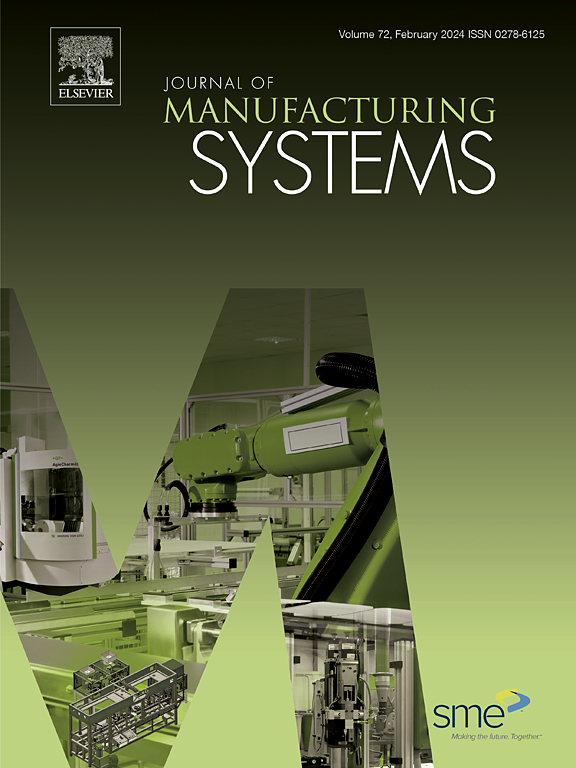一种新的基于xr的工业4.0实时机器交互系统:学习型工厂的可用性评估
IF 14.2
1区 工程技术
Q1 ENGINEERING, INDUSTRIAL
引用次数: 0
摘要
传统的数据可视化和过程监控方法在快节奏、数据密集型的制造环境中越来越不适应。扩展现实(XR)技术,包括增强现实(AR)、虚拟现实(VR)和混合现实(MR),在工业4.0框架下具有增强人机交互和运营效率的潜力。虽然以前的研究已经证明了XR在组装、培训、维护和人机交互等领域的有效性,但对开发和评估用于实时机器数据可视化的XR系统的关注有限。大多数现有研究都侧重于展示AR应用,而没有与其他XR技术或传统人机界面(hmi)进行严格的比较评估,通常用户测试有限。本研究通过开发和评估在学习型工厂环境中使用Microsoft HoloLens 2进行实时过程控制的XR应用程序来解决这些差距。一种混合方法,包括实验设计、调查和时间测量,将XR系统与传统的2D hmi进行了比较。分析了来自22个参与者的数据,重点关注警报响应时间、可用性和预防性维护。研究结果表明,与传统的hmi相比,XR系统显著改善了报警响应时间,增加了预防性补充的频率,并提高了可用性。然而,人们注意到与人体工程学和有限的视野有关的挑战。这项研究通过展示XR在改善人机界面和促进机器与操作员之间更好互动方面的潜力,有助于推进智能制造。本文章由计算机程序翻译,如有差异,请以英文原文为准。

A novel XR-based real-time machine interaction system for Industry 4.0: Usability evaluation in a learning factory
Traditional methods of data visualization and process monitoring are increasingly inadequate in fast-paced, data-intensive manufacturing environments. Extended Reality (XR) technologies, including Augmented Reality (AR), Virtual Reality (VR), and Mixed Reality (MR), have the potential to enhance human–machine interaction and operational efficiency in Industry 4.0 framework. While previous research has demonstrated the effectiveness of XR in areas such as assembly, training, maintenance, and human–robot interaction, limited attention has been given to developing and evaluating XR systems for real-time machine data visualization. Most existing studies focus on demonstrating AR applications without rigorous comparative evaluations against other XR technologies or traditional Human–Machine Interfaces (HMIs), often with limited user testing. This study addresses these gaps by developing and evaluating an XR application using Microsoft HoloLens 2 for real-time process control in a Learning Factory environment. A mixed-methods approach, including experimental design, surveys, and time measurements, compared the XR system with conventional 2D HMIs. Data from 22 participants were analyzed, focusing on alarm response times, usability, and preventive maintenance. The findings show that the XR system significantly improves alarm response times, increases frequency of preventive refills, and enhances usability compared to traditional HMIs. However, challenges related to ergonomics and limited field of view were noted. This study contributes to advancing smart manufacturing by showcasing the potential of XR to improve human–machine interfaces and foster better interaction between machines and operators.
求助全文
通过发布文献求助,成功后即可免费获取论文全文。
去求助
来源期刊

Journal of Manufacturing Systems
工程技术-工程:工业
CiteScore
23.30
自引率
13.20%
发文量
216
审稿时长
25 days
期刊介绍:
The Journal of Manufacturing Systems is dedicated to showcasing cutting-edge fundamental and applied research in manufacturing at the systems level. Encompassing products, equipment, people, information, control, and support functions, manufacturing systems play a pivotal role in the economical and competitive development, production, delivery, and total lifecycle of products, meeting market and societal needs.
With a commitment to publishing archival scholarly literature, the journal strives to advance the state of the art in manufacturing systems and foster innovation in crafting efficient, robust, and sustainable manufacturing systems. The focus extends from equipment-level considerations to the broader scope of the extended enterprise. The Journal welcomes research addressing challenges across various scales, including nano, micro, and macro-scale manufacturing, and spanning diverse sectors such as aerospace, automotive, energy, and medical device manufacturing.
 求助内容:
求助内容: 应助结果提醒方式:
应助结果提醒方式:


